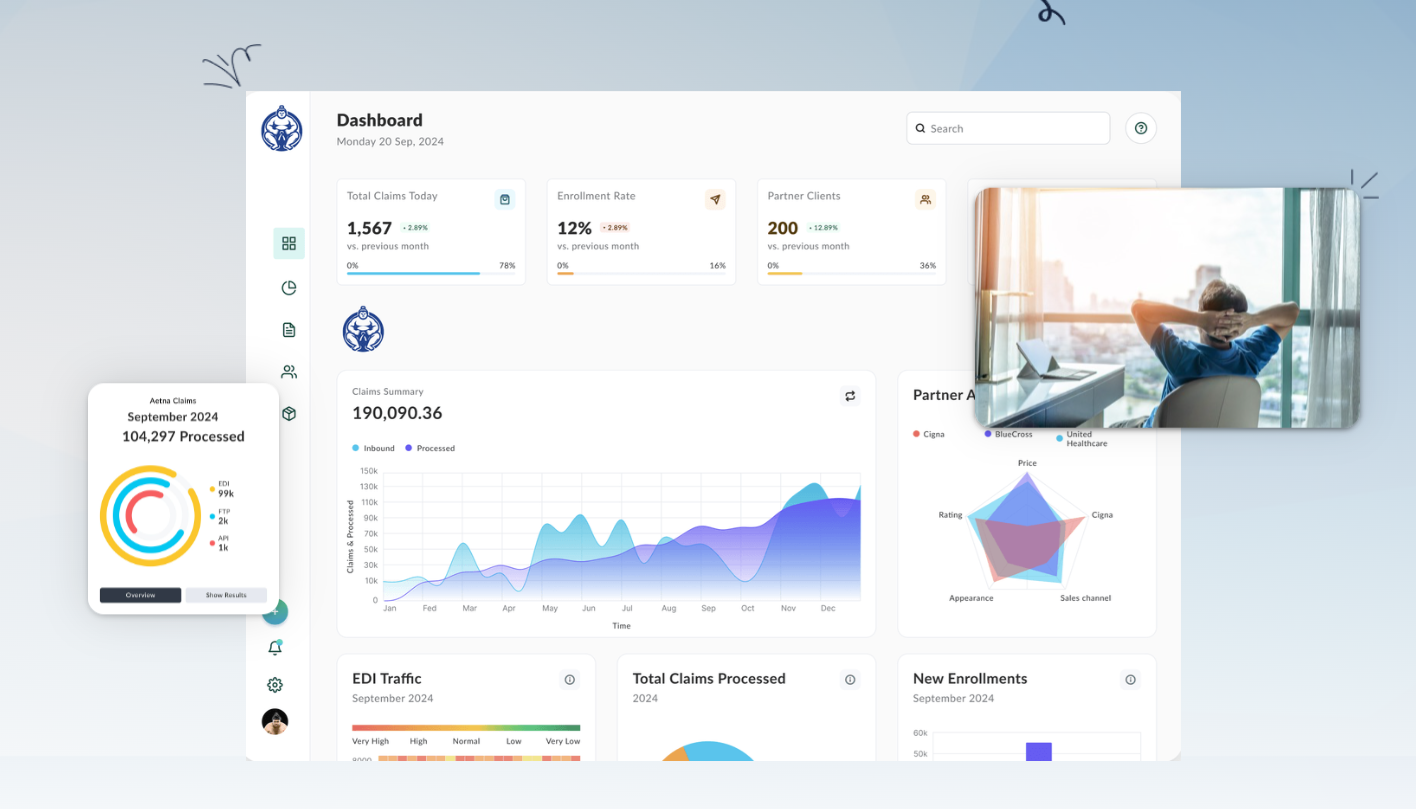EDI Health Insurance Basics: A Complete Guide to Understanding Formats, Compliance, and Integration


Navigating the world of electronic data interchange (EDI) in health insurance is both an opportunity and a challenge. As partners to payer organizations, at EDI Sumo we’ve witnessed confusion and bottlenecks caused by legacy formats, brittle compliance requirements, and integration issues that stall operations and impact service level agreements. This guide is designed to break down the basics, bust common myths, and provide practical clarity — from file formats to compliance checkpoints and seamless integrations. Whether you’re a CIO, EDI director, or claims management leader, we hope this resource saves you time, reduces your risk, and gives you confidence in your EDI roadmap.
Why EDI is Essential for Health Insurance Payers
Electronic data interchange is the lifeblood of every health insurance organization. It standardizes information exchange between payers, providers, trading partners, and regulatory bodies, powering everything from member enrollment and eligibility to claims processing and reporting. When implemented correctly, EDI helps reduce manual errors, speed up transactions, minimize administrative burden, and provide the transparency required by modern compliance frameworks like HIPAA.
Understanding the Core Health Insurance EDI Formats
Let’s clear up the confusion about formats. Health insurance EDI can be delivered in multiple ways: the X12 EDI standard (commonly called ANSI X12), CSV/Excel, positional files, and XML, to name a few. The challenge for most payer organizations is not just handling these different formats individually, but being able to normalize and standardize data so that downstream systems are never starved for information or plagued by inconsistencies.
- EDI 834 Transaction – The gold standard for enrollment data exchange. Used for transmitting new member enrollments, changes, and terminations between employers, exchanges, and payers. Getting this right (see detailed section below) is foundational for eligibility accuracy.
- EDI 837 Transaction – The essential format for claims submissions. Used by providers to submit healthcare claims to payers. Precision here determines payment speed and denial rates.
- EDI 999 and 277 – Transaction acknowledgments and status feedback. 999 is used to acknowledge whether a transaction was accepted or rejected. 277 provides detailed claim status responses.
- Other Core X12 Transactions – 270/271 (eligibility inquiry/response), 276/277 (claim status inquiry/response), 278 (authorization/referral), and more.

EDI 834 Transactions Explained: The Foundation of Enrollment Data
The EDI 834 transaction forms the backbone of insurance member enrollment, coverage updates, and disenrollment communications between employers, government exchanges, and health plans. It’s highly structured, including details like subscriber demographics, dependent relationships, coverage dates, product selections, and more.
Key challenges we tackle with EDI 834 processing at EDI Sumo:
- Multi-source file intake: Whether files arrive as X12 EDI, CSV/Excel, or another format, our platform standardizes data and provides a single pane of glass for analysis.
- Real-time monitoring: Instead of waiting for IT, eligibility teams can track every enrollment file in progress, spot errors, and answer questions from internal departments or auditors instantly.
- Automated error detection: Early flagging and alerts for data mismatches, missing fields, coverage gaps, or downstream system errors so they can be resolved before impacting claims.
- Audit trails: Full traceability to meet HIPAA and regulatory requirements without resorting to labor-intensive manual logs.
Enrollment accuracy is non-negotiable — small errors can snowball into denied claims, member dissatisfaction, and compliance headaches. For more on our approach to eligibility processing, see how EDI Sumo streamlines eligibility management.
What Are SNIP Levels? A Practical Guide for Payers and Providers
Compliance and data integrity are at the center of any successful EDI operation. The Workgroup for Electronic Data Interchange (WEDI) established SNIP (Strategic National Implementation Process) Levels to set out a framework for EDI validation, ranging from basic syntax all the way to clinical code checks. Understanding these levels helps you identify where your errors are occurring and how to resolve them proactively.
- Level 1: EDI Syntax (basic formatting errors, required fields, segment order)
- Level 2: HIPAA compliance (structure dictated by the implementation guides)
- Level 3: Balancing (quantity/monetary value validations across transactions)
- Level 4: Inter-segment situation testing (relationships between segments)
- Level 5: Code set testing (validity of data in specific code sets/values)
- Level 6: Product type and benefit testing
- Level 7: Implementation-specific requirements unique to a trading partner
Most payers and providers struggle beyond Level 2 without automation, which exposes them to rejected files, slowdowns, and penalties. EDI Sumo supports WEDI/SNIP Levels 1-7 validation and real-time alerting so compliance becomes proactive, not reactive.
EDI 999 vs. 277: What’s the Difference and Why It Matters for Payers
Encountering EDI 999 and 277 files is a rite of passage for every healthcare payer. But not everyone knows how to interpret the differences or use them strategically. Here’s a quick, practical breakdown:
- EDI 999 (Acknowledgment): Shortly after you send a batch (such as an 837 or 834), you should receive a 999, which confirms whether the file is accepted (passes X12 and HIPAA compliance) or is rejected due to formatting or content errors. Fast 999 turnaround mitigates the risk of downstream errors.
- EDI 277 (Claim Status Response): Specifically for claims, 277 responses provide a granular view of each claim’s journey—accepted for processing, pending, denied, or needing more information. The 277 reduces ambiguity and gives both your operations and customer service teams early warning of issues before members or providers call to complain.
Seamlessly tracking the status of inbound and outbound EDI files matters not only for SLAs, but also for end-to-end data integrity. Our clients regularly tell us that real-time 999/277 monitoring and actionable alerts are mission-critical for their teams. To see these workflows in action, visit our customer service solution page.
EDI 837 Claims Transactions: Why Accuracy and Speed Matter for Payers
The EDI 837 transaction stands at the heart of healthcare claims management. This format is responsible for communicating patient, service, and payment details from providers to payers. The margin for error is razor-thin, as even minor data quality issues can disrupt payment cycles, increase denials, and balloon operational costs.
Based on our experience, payers face the following obstacles with EDI 837:
- High claim volume and complexity: Manually inspecting or correcting claims isn’t sustainable. Automation is critical.
- Custom validation needs: Different payers and providers have unique business rules and requirements beyond standard formats. These aren’t always well documented.
- Integration with multiple legacy and modern systems: Most payer environments run a mix of platforms (claims adjudication, EDI translators, CRMs). Data must be normalized for accurate, downstream processing.
- Regulatory/SLAs: Timely acceptance, acknowledgment, and error remediation drive revenue cycle performance and help avoid penalties or audit findings.
Tools that provide real-time claim monitoring, automated error detection, and seamless integration help move your organization from firefighting mode to truly optimized claim cycles.
Why Integration Matters: Beyond File Transfer
Many organizations believe EDI stops at file transfer, but true value comes from integrating EDI into your business workflows. Integration empowers your teams to:
- Provide real-time access to claims, eligibility, and enrollment data for support, compliance, and operations staff (not just IT and EDI teams)
- Reduce duplication of effort and eliminate data silos across the enterprise
- Automate critical business logic (claim splits, notifications, reporting back to trading partners)
- Strengthen compliance and oversight, so audits and regulatory reporting are supported by full, automated audit trails
EDI Sumo is designed to connect easily with claims management systems, EDI translators, and enrollment platforms to bridge gaps, standardize all formats (X12, CSV, XML), and empower non-technical teams with self-serve data access.
Key Steps in Building a Reliable, Auditable EDI Operation
- Normalize all inbound and outbound formats. Don’t let file format variety become a roadblock. Invest in solutions that ingest and standardize data regardless of how your trading partners send it.
- Automate validations and error reporting. Manual fixes and detective work are unsustainable. Automation for SNIP Level validations, custom payer rules, and real-time alerts are essential.
- Strengthen audit trail generation. Robust logging, audit trails, and role-based access controls are not only for compliance-they’re also vital for operational transparency and accountability.
- Centralize monitoring and dashboards. Give visibility to business units (customer support, enrollment, claims)—not just IT—so issues are spotted and fixed faster.
- Ensure tight security and compliance. HIPAA compliance is ongoing, not a checkbox. Encryption, user controls, and privacy safeguards protect members and your business alike.
What Makes EDI Sumo Different?
If you’re navigating the costs of SLA penalties, compliance anxiety, or repetitive manual EDI tasks, you’re not alone. At EDI Sumo, our platform is purpose-built for health insurance payers. We centralize and standardize all formats, enable deep monitoring (including SNIP compliance), automate error detection, and integrate with your existing systems so that business and IT users are empowered, not overwhelmed.
- HIPAA and audit-ready out of the box
- Real-time dashboards and alerts
- Unified user-friendly interface for all EDI processes
- Seamless integrations with major claims, CRM, and translation systems
Ready to see the difference for your organization? Connect with our team to schedule a demo or learn more about our solutions for payers.


.png)





.png)

.png)


.png)
